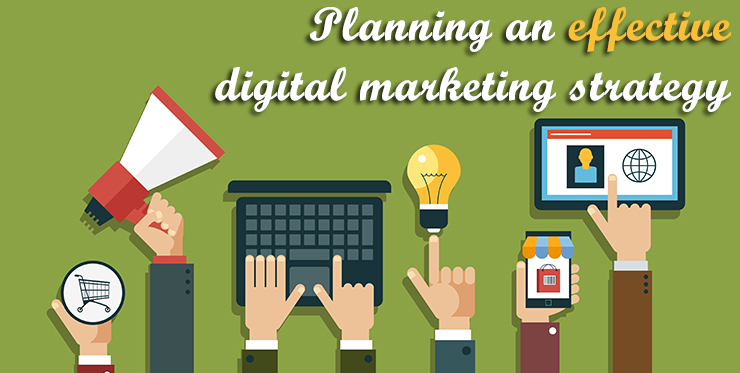Planning an effective digital marketing strategy

Imagine if you went to your local car dealership to purchase a car and the salesman said you had to pay up front, but you couldn’t start using the car for three months, or even six months. You would probably laugh in their face.
We live in a time of instant gratification. We want results for our monthly and quarterly reports yesterday, especially if outside investors are involved. The pressures to hit short-term deadlines can easily cloud our judgments and cause us to overlook the benefits of optimizing for long-term goals.
The truth is, however, that an effective marketing strategy involves careful consideration of both short and long-term goals. And it’s important to understand this from the get-go.
I’m not saying you can’t find ways to get results right away. But those tactics often require a little more hands-on effort, and they are not as scalable as you start to grow.
This need for balance is exactly why so many marketers have been writing about the importance of running paid and organic digital marketing campaigns as a cohesive strategy.
Whether you are trying to prove results to a boss, client, or just want to run a good marketing strategy that works – you have to optimize for short andlong-term goals. And while there are a lot of benefits to running paid and organic together, this is the best way to get quick wins while also setting yourself up for long-term success in digital marketing.
The Ramp Up Time
There should always be a planning period, no matter what results you seek. Even if you take hours instead of weeks, you have to build a strategy. I’m going to repeat that – you HAVE to build a strategy – if you want to optimize your campaign.
That’s not to say it’s impossible to publish a random blog that gets picked up by a journalist at Lifehacker and drives half a million visits to your website in a day. But it’s not likely, and it’s not scaleable.
Building out your strategy ahead of your campaign:
- Gives you a roadmap
- Establishes goals, timelines, and metrics
- Provides content direction through research
- Increases the effectiveness of your campaign
- Prepares you to collect all the new leads with infrastructure
The timeline for this ramp up period will vary depending upon the extent of marketing research you’ve already done for your organization. If you have a lot of open time on your hands and you’ve already laid the groundwork, you may be able to finish in hours, days, or weeks. But if it’s just one item on a full plate, strategy planning could take months.
Here’s what needs to happen first for your digital marketing strategy planning to be effective:
- Define a value proposition
- Conduct target market research
- Build out personas
- Map your buyer’s journey
Yes, you could kick off a paid campaign right away and start driving traffic. But where will your campaign lead them? Do you have a landing page that speaks to them in their language? Do you have a way of collecting their information that they will want to complete?
In other words, you will be throwing money away if you don’t set up a solid foundation for your marketing strategy.
If I sound like I’m on a soapbox a bit, I probably am. I work in the fast-paced software industry where everyone wants everything done yesterday. This was quite a change coming from the higher education industry in which we would set up meetings, to make a plan, to build a strategy, to plan a campaign…you get the idea.
Lately, it seems I spend a lot of time trying to sell the importance of a strong foundation because it’s not tangible. But it’s so worth it. At the end of the day, your balance sheet will thank you. <End Rant>
SEO and Inbound Marketing
Once you have a foundation set for all of your marketing strategies, it’s time to start thinking about the sort of results you want for your website. Do you want it to build equity that results in lower costs of acquisition over time? Do you want it to start pulling in leads you don’t have to pay for?
If you’ve answered yes, you should make sure your digital marketing strategy includes a healthy dose of search engine optimization and inbound marketing. As you build rankings and traffic for important terms, each of the terms will start to stack on each other exponentially.
The upside of a content-driven inbound marketing strategy is equity. Let’s do a really simple math example (which does not account for variation and the law of diminishing returns), but will help create a picture.
Say each piece of content starts to rank for a keyword that drives an average of 250 visits a month. Over time, new pieces of content will start to stack on top of each other. By the third piece, if you are doing the math with me, you will be driving a total of 750 visits a month. In other words, you are building equity and the original amount that it cost you to write the content ends up decreasing over time.
Slow and Steady
The downside is that this process takes time. In fact, it can take quite a bit of time. The web is getting saturated with content. There was a time where almost any business could take up blogging and start to rank for juicy, traffic-heavy keywords immediately.
Now, you will have to invest a lot of time and effort up front to create a large volume of quality content on your website before you can even hope to start ranking for the high-volume keywords. And to make matters worse, you probably can’t just hit publish and go on about your day. You will likely have to get your hands dirty and distribute the content on social media, forums, and other content amplification venues. All this adds up to more time.
In a joint study with MIT of all Hubspot customers, researchers found it can take six to 12 months for your website to start experiencing gains from search engine and keyword optimized content.
Inbound Results
Depending on your website’s current traffic, the average increase after one year of optimized inbound marketing efforts, you can only expect an average of 4.1x more traffic per month according to the same survey (with the breakout of increase by size illustrated above). Now don’t get me wrong, a four times increase can add up. But it’s by no means the best you can do in the digital marketing space.
Furthermore, if you are starting from ground zero, 4.1x growth can be frustrating – and frankly may not be the smartest use of your full time and effort. But fear not, inbound marketing, SEO, and blogs don’t need to and should not exist in a vacuum.
Maximizing Results with Paid Strategies
Paid strategies are the perfect complement to organic efforts because they allow for quick wins and short-term results, and can even help you optimize your long-term strategies. There are a lot of things you can do on paid platforms that are simply not possible at the onset of an organic campaign.
Bring in Traffic Sooner
The first and most obvious benefit of running paid strategies early on is boosting visitors to your website. It can be challenging to get those first surges of traffic organically if you have a relatively unknown brand. Advertising through search platforms allows you some visibility on keywords that you don’t have a chance at right away.
And with paid taking up almost half of the results now, the extra visibility can add up quickly. Some options like Facebook advertising also have incredibly low costs per click still. If you are paying $0.10 per click, you can drive some serious, highly-targeted traffic with as little as $25.
Test Your Strategies
A/B testing and other methods of systematic measurement require time and volume. Many experts say you need a sample size of at least 5,000 within a certain time frame for accuracy in your website’s A/B testing results.
Paid provides the opportunity to test for keywords, phrasing, and calls to action in higher volumes right away. The takeaways from your paid tests can be applied directly to your organic strategy.
Remind Visitors to Hurry Back
One of the tenants of inbound marketing is to capture leads at every stage of their purchase process, from discovering they have a need at the awareness stage, to choosing a solution at the decision stage.
Organic strategies take time to fill in the answers for potential customers along their journey – and that can be a good thing because it builds trust and confidence in your brand. But, you can give these efforts a little boost by dropping some remarketing cookies on your visitors so you can remind them they enjoyed what they read. This will help keep you at the top of their mind and encourage them to come back sooner.
The Digital Marketing PB&J
Organic and paid marketing strategies truly do go together like peanut butter and jelly. At the risk of starting a big debate about nutrition (to which I am certainly not an expert):
- Jelly is made up of the paid efforts that get you the sugary bursts of energy right away,
- Organic optimization is chock full of peanut buttery protein that helps build a steady stream of that energy over the long-haul.
Put paid and organic together, and you’ll be able to cook up some digital marketing magic.
___
by Katy Katz

